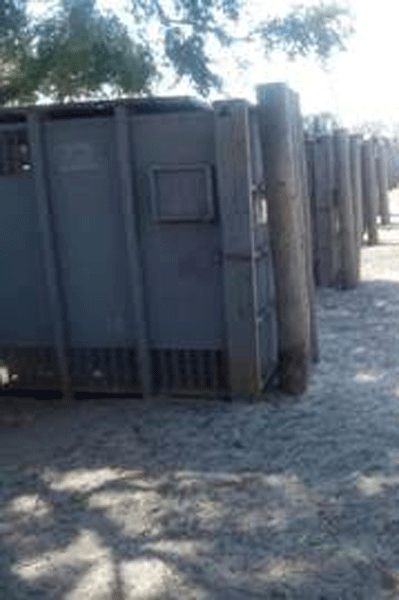
Since February this year, the Zimbabwean authorities, working hand in glove with Chinese authorities, have greatly intensified the capturing of animals in the country for export to China, according to a report by the Zimbabwe Conservation Task Force (ZCTF).
environment: By Chipo Masara

ZCTF is a non-profit organisation that has for years dedicated its time and resources towards the protection of the country’s wildlife.
The organisation claims it is “aware of eight lions, four giraffes, eight hyenas and 40 elephants that have been captured already and are waiting to be sent to Chimelong Safari Park in China”. The move (capturing the animals), the organisation said, is in a bid by the Zimbabwean authorities to fulfil their order of 130 elephants and 50 lions to China.
According to ZCTF, those that have been assigned to capture elephants are reportedly using bull hooks to coax them in and out of containers as they prepare them for their long trip to the Asian country. The capturing of the elephants is believed to have left the animals’ family units “severely disrupted and damaged”— a development the organisation fears will in turn inevitably result in conflict between humans and the animals.
ZCTF says it has been brought to their attention that one of the young lions that have so far been allegedly captured, may be one of the male pride members of the late Cecil the Lion — whose killing by an American dentist Walter Palmer over a year ago attracted global outrage. The young lion may have been captured and is ready for export to China.
Reports also say other captured animals have been killed so that they can be sold as trophies. This is especially so for the animals with big and attractive horns, the organisation said.
ZCTF chairman Johnny Rodrigues bemoaned the alleged capturing of the animals.
- Chamisa under fire over US$120K donation
- Mavhunga puts DeMbare into Chibuku quarterfinals
- Pension funds bet on Cabora Bassa oilfields
- Councils defy govt fire tender directive
Keep Reading
“You do not take baby elephants away from their families to a new place and new environment and expect them to cope. They won’t,” said Rodrigues.
“These animals do not belong to ZimParks [Zimbabwe Parks and Wildlife Management Authority] or the government. They belong to all Zimbabweans. It’s our heritage that we are letting them steal from us and future generations.”
Rodrigues rubbished as untrue the claims by authorities that they were “relocating” animals from Hwange, saying this was a well-orchestrated move meant to capture animals and export them directly out of the Hwange area instead of transporting them through to the Harare International Airport, like the animal capture that took place last year and raised a lot of eyebrows. To aid the transactions, the runway airstrip in Victoria Falls has reportedly been lengthened so that bigger aeroplanes are able to land there.
In a press statement, Caroline Washaya-Moyo, spokesperson for ZimParks, declared ZCTF and Rodrigues’claims were false and designed “only to taint the reputation of the Authority ahead of the Seventeenth Meeting of the Conference of Parties to the Convention on the International Trade in Endangered Species of Wild Fauna and Flora (Cites COP 17)”.
“The only elephants that have been captured will be translocated to Chirisa National Park under the Wildlife Drought Mitigation Strategy (2015 – 2016)”, the statement reads.
State media, however, reported that since July last year, Zimbabwe had sold 100 elephants, out of a population of more than 84 000, to China. They were sold for about $40 000 each, according to wildlife officials.
According to Environment minister Oppah Muchinguri-Kashiri, exporting wildlife to China would help reduce the chances of them dying because of drought.
“The Chinese have enquired about more elephants, baboons, hyenas, lions, among others, and we will sell them more without hesitation. We are not going to apologise to anyone,” Muchinguri-Kashiri is reported to have said on her visit to China in January this year.
Muchinguri-Kashiri added that Zimbabwe was looking at acquiring drones and helicopters for surveillance purposes because poachers were becoming increasingly sophisticated, and the government was looking to China for help. Rodrigues, however, said he found the mere fact that Zimbabwe would turn to China for assistance to deal with poachers laughable.
“They [Chinese] say that they are helping with poaching in Zimbabwe, but we suspect that they are actually the ones majorly behind the poaching. There is some minister or someone playing games here. Now they are saying that there is no food [for the animal], that it is overcrowded. That’s a lie,” said Rodrigues.
China is the world’s largest ivory consumer, with its legal market often providing cover for illegal ivory. Elephants are especially in crisis and every year, approximately 35 000 are reportedly killed, largely to supply the illegal international trade in ivory and meet demand in Asia – primarily China.
This explains why claims by the Environment minister that animals, especially elephants, will be much safer in China have been scoffed at, with many equating it to getting them “out of the frying pan into the fire”.
For feedback, email:[email protected]











